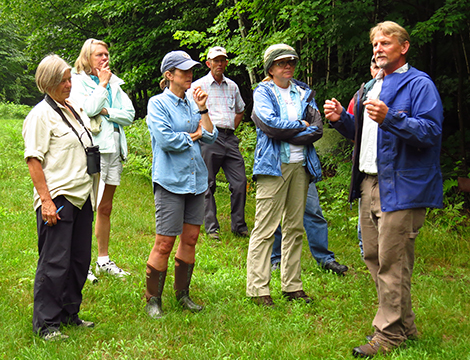
On a recent July morning, about 24 of us gathered on the porch of Bluewater Farm at Bradley Lake to attend an event in the Taking Action for Wildlife program sponsored by the Andover Conservation Commission (ACC). ACC Chair Mary Anne Broshek introduced Dave Anderson, Director of Education and Volunteer Services for the New Hampshire Society for the Preservation of Forests.
Right away, Dave launched into an overview of the past 13,000 years of Central New England. Starting with the mile thick Laurentide Ice Sheet, he guided us through a history of the forces – geologic, climatic, and human – that have shaped our local landscape. That took less than 15 minutes! Then we stepped off the porch and into the woods, where Dave could point to the evidence of the concepts outlined in that whirlwind survey.
Anybody who has been on a walk-and-talk with Dave or read one of his essays knows that he combines a vast knowledge of the natural world with a stunning gift for language. He uses similes and metaphors, both for their poetry and their power to make a complicated concept understandable and memorable.
For example, if one takes a Swiss watch apart and then puts it back together, there will be problems if some parts are left over. All the pieces, no matter how tiny, are crucial to the smooth working of the watch. So it is with an ecosystem.
Dave reminded us that Central New Hampshire is in a transition zone between the temperate deciduous forest to our south, starting in Georgia, and the coniferous forests north of us into Labrador. Because we live in the overlap, we enjoy a wider diversity of species than any other area in the Northeast.
Some evidence of that diversity was in the maps on display on the porch at Bluewater Farm, especially the one with colors to indicate which parts of Andover qualify as prime wildlife habitat … most of it! No wonder there are so many stickers on the map showing the locations of wildlife sightings.
As we walked past a large standing dead tree, Dave explained why it is a good idea to leave such snags in place. That’s home for many of the birds we enjoy observing at our feeders in the winter, as well as many small mammals.
Similarly a cut-over area with lots of scratchy stalks and junky-looking shrubs is not all bad. According to Dave, the messier the landscape, the better it is for wildlife; horizontal and vertical variety is important.
Walking with Dave is like stepping into the pages of Tom Wessell’s gem of a book, Reading the Forested Landscape, and having it come to life around you. To understand what you are seeing, it helps to know about succession and disturbance, sheep farming and timber harvesting, substrate and topography.
We are in our fourth forest now – one very different from the first – and it is fascinating to note that New Hampshire has changed from 80% cleared land in the recent past to 83% forested now. By percentage, we are the second-highest forested state in the nation, second only to Maine.
The pine we see now is a legacy of our agricultural past. Pine needs open areas like old pastures to grow. Notice that after a logging harvest, the pine regenerates on the skid trails where there is plenty of sunlight and the ground is scarified enough for the tiny seeds to get down into the soil.
Dave pointed out that we manage the forests for our human needs; the forest doesn’t care. Now that habitat management has replaced species preservation as the primary strategy for protecting wildlife, it is crucially important that we landowners and voters try to understand the issues using a long time scale and some humility about our relatively brief presence.
As Jack Ward Thomas, former Chief of the U.S. Forest Service wrote, “Ecosystems are not only more complex than we know, they are more complex than we can know.”
Programs such Taking Action for Wildlife can help us appreciate and understand those complexities; the ACC deserves our gratitude for planning such worthwhile events.